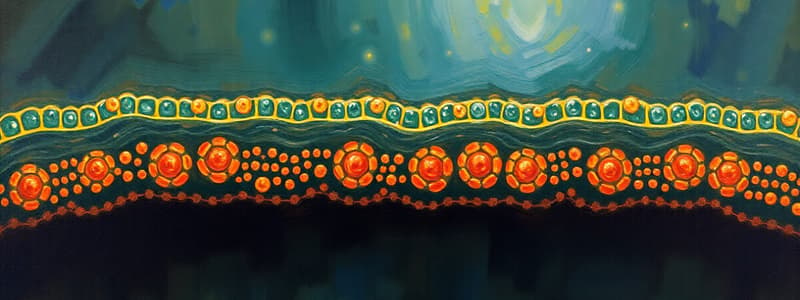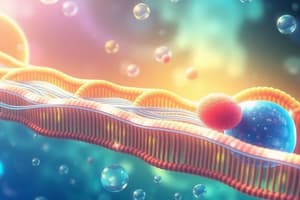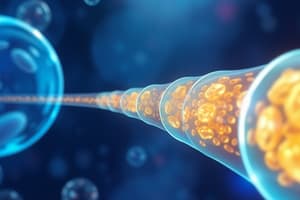Podcast
Questions and Answers
What is one primary function of the cell membrane?
What is one primary function of the cell membrane?
Which component is NOT part of the fluid mosaic model of the cell membrane?
Which component is NOT part of the fluid mosaic model of the cell membrane?
How does active transport differ from passive transport?
How does active transport differ from passive transport?
Which of the following is a type of passive transport?
Which of the following is a type of passive transport?
Signup and view all the answers
What role do glycolipids serve in the cell membrane?
What role do glycolipids serve in the cell membrane?
Signup and view all the answers
Which process describes the movement of water across a semipermeable membrane?
Which process describes the movement of water across a semipermeable membrane?
Signup and view all the answers
What is the significance of Brownian motion in cell transport?
What is the significance of Brownian motion in cell transport?
Signup and view all the answers
Endocytosis and exocytosis are types of which transport mechanism?
Endocytosis and exocytosis are types of which transport mechanism?
Signup and view all the answers
The fluid mosaic model explains the structure of which cellular component?
The fluid mosaic model explains the structure of which cellular component?
Signup and view all the answers
Maintaining homeostasis is essential for which reason?
Maintaining homeostasis is essential for which reason?
Signup and view all the answers
What role do carrier proteins play in facilitated diffusion?
What role do carrier proteins play in facilitated diffusion?
Signup and view all the answers
Which of the following statements about ion channels is true?
Which of the following statements about ion channels is true?
Signup and view all the answers
What distinguishes active transport from facilitated diffusion?
What distinguishes active transport from facilitated diffusion?
Signup and view all the answers
What is the primary function of the Sodium/Potassium Pump?
What is the primary function of the Sodium/Potassium Pump?
Signup and view all the answers
What is the process of endocytosis primarily used for?
What is the process of endocytosis primarily used for?
Signup and view all the answers
Which type of endocytosis involves the ingestion of large particles or whole cells?
Which type of endocytosis involves the ingestion of large particles or whole cells?
Signup and view all the answers
How do exocytosis and endocytosis differ?
How do exocytosis and endocytosis differ?
Signup and view all the answers
What is the primary purpose of the vesicles formed during endocytosis?
What is the primary purpose of the vesicles formed during endocytosis?
Signup and view all the answers
Which function does exocytosis serve in the nervous and endocrine systems?
Which function does exocytosis serve in the nervous and endocrine systems?
Signup and view all the answers
What is the primary direction of molecular movement during diffusion?
What is the primary direction of molecular movement during diffusion?
Signup and view all the answers
Which component of the cell is primarily responsible for transportation across the cell?
Which component of the cell is primarily responsible for transportation across the cell?
Signup and view all the answers
What happens to a plant cell in a hypotonic solution?
What happens to a plant cell in a hypotonic solution?
Signup and view all the answers
What characterizes an isotonic solution?
What characterizes an isotonic solution?
Signup and view all the answers
During osmosis, water molecules move from areas of ___ to areas of ___.
During osmosis, water molecules move from areas of ___ to areas of ___.
Signup and view all the answers
Which of the following processes describes the bursting of an animal cell due to excessive water intake?
Which of the following processes describes the bursting of an animal cell due to excessive water intake?
Signup and view all the answers
What happens during plasmolysis in plant cells?
What happens during plasmolysis in plant cells?
Signup and view all the answers
In terms of energy, how is the process of diffusion characterized?
In terms of energy, how is the process of diffusion characterized?
Signup and view all the answers
Which type of solution has a higher concentration of solute outside the cell than in the cytosol?
Which type of solution has a higher concentration of solute outside the cell than in the cytosol?
Signup and view all the answers
What is the main purpose of mitochondria in the cell?
What is the main purpose of mitochondria in the cell?
Signup and view all the answers
Study Notes
Cell Transport Overview
- Cell transport encompasses the movement of various substances (CO2, O2, H2O, glucose, proteins, etc.) across the cell membrane.
- Cell membranes serve as a boundary between the cell's internal environment (cytoplasm) and its surroundings.
- Membranes facilitate transport into and out of cells, and cells constantly receive and respond to stimuli.
- Membranous organelles, such as mitochondria, are also involved in cell transport processes.
Cell Membrane Composition
- The cell membrane's core is a phospholipid bilayer.
- The bilayer consists of hydrophilic (water-loving) heads and hydrophobic (water-fearing) tails.
- Other components include cholesterol, glycoproteins, and glycolipids.
- The fluid mosaic model describes the membrane's structure, with components (like proteins and phospholipids) that can move laterally within the membrane.
Protein Functions
- Proteins play various roles within the cell membrane.
- Intercellular Joinings: These proteins connect adjacent cells.
- Enzymatic Activity: Certain proteins act as enzymes.
- Transport: Proteins facilitate the movement of substances (active or passive transport).
- Cell-Cell Recognition: Proteins help identify one cell from another.
- Anchorage: Proteins attach the cytoskeleton to the cell membrane.
- Signal Transduction: Proteins receive signals from outside the cell.
Types of Cell Transport
-
Active Transport: Moves substances against their concentration gradient (lower to higher concentration), requiring energy (usually ATP).
- Example: Sodium-Potassium pump.
-
Passive Transport: Moves substances along their concentration gradients (higher to lower concentration), requiring no energy input from the cell.
- Types of passive transport: Diffusion, Osmosis ,Facilitated Diffusion.
Passive Transport Mechanisms
- Diffusion: The movement of molecules from a region of high concentration to one of low concentration.
- Osmosis: The specific movement of water across a selectively permeable membrane from a region of high water concentration to one of low water concentration.
- Facilitated Diffusion: Facilitated movement of molecules that can't quickly pass directly through the lipid bilayer, aided by carrier proteins.
Solution Types
- Hypotonic: A solution with a lower solute concentration than the cell's cytoplasm. Water moves into the cell, potentially causing it to swell or burst (cytolysis in animal cells, turgor pressure in plant cells).
- Hypertonic: A solution with a higher solute concentration than the cell's cytoplasm. Water moves out of the cell, potentially causing it to shrink (crenation in animal cells, plasmolysis in plant cells).
- Isotonic: A solution with an equal solute concentration to the cell's cytoplasm. Water moves in and out of the cell at equal rates, maintaining cell shape.
Cell Transport, and Its Importance
- Homeostasis: Maintaining a stable internal environment.
- Metabolism: Converting food into energy via chemical reactions.
- Equilibrium: Equal concentrations of molecules across a cell membrane or system.
-
Types of Extreme Osmosis and Their Effects:
- Crenation: Dehydration of animal cells.
- Plasmolysis: Dehydration of plant cells.
- Cytolysis: Cell bursting (usually occurs in animal cells).
Bulk Transport
-
Endocytosis: The process of taking material into the cell, forming vesicles or vacuoles from the cell membrane.
- Types of endocytosis:
- Pinocytosis: Taking in liquids.
- Phagocytosis: Taking in solid particles or whole cells (as in immune system function).
- Types of endocytosis:
- Exocytosis: The process of releasing materials from the cell.
Key Components of Cell Transport
- Cell membrane: phospholipid bilayer.
- Cytoplasm: aqueous solution that contains materials needed for cell functions.
- Mitochondria: powerhouse of the cell, converting glucose into ATP for energy.
- Red blood cells (RBCs): Carry hemoglobin for transporting oxygen and carbon dioxide.
Important Definitions
- Solute: A substance that dissolves in a solvent.
- Solvent: A substance that dissolves a solute.
- Solution: A homogeneous mixture of solute and solvent.
- Brownian Motion: The random movement of particles due to collisions.
Studying That Suits You
Use AI to generate personalized quizzes and flashcards to suit your learning preferences.
Related Documents
Description
Explore the essential functions of cell transport and the composition of cell membranes in this quiz. Understand how substances move across cell membranes, the structure of the phospholipid bilayer, and the roles of proteins within the membrane. Perfect for students studying cell biology!



